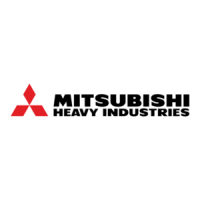Why do I hear a cracking sound from my Mitsubishi Heavy Industries Air Conditioner?
- CcrystaldeanSep 7, 2025
If you hear a slight cracking sound from your Mitsubishi Heavy Industries Air Conditioner, it's due to heat expansion or contraction.

Why do I hear a cracking sound from my Mitsubishi Heavy Industries Air Conditioner?
If you hear a slight cracking sound from your Mitsubishi Heavy Industries Air Conditioner, it's due to heat expansion or contraction.
Why is my Mitsubishi Heavy Industries Air Conditioner making a hissing or clicking sound?
If you hear a hissing or clicking sound from your Mitsubishi Heavy Industries Air Conditioner, it's caused by the operation of the refrigerant control valves or electric components.
What to do if my Mitsubishi Heavy Industries DXK12Z5L-S Air Conditioner doesn't restart after a power cut?
If your Mitsubishi Heavy Industries Air Conditioner does not restart after a power cut, even when power is restored, it's because the auto-restart function may not be set. Use the remote control to start the operation again.
Why does moisture form on the air outlet grills of my Mitsubishi Heavy Industries DXK12Z5L-S Air Conditioner?
If moisture forms on the air outlet grills of your Mitsubishi Heavy Industries Air Conditioner, it may be due to prolonged operation in high humidity. The moisture may form and start dripping.
Why is my Mitsubishi Heavy Industries DXK12Z5L-S outdoor unit making a whistling noise?
If you hear a whistling noise from the outdoor unit of your Mitsubishi Heavy Industries Air Conditioner, it indicates that the revolution speed of the compressor is increasing or decreasing.
| Cooling Capacity | 3.5 kW |
|---|---|
| Heating Capacity | 4.0 kW |
| Power Supply | 220-240V, 50Hz |
| Indoor Unit Dimensions (W x H x D) | 845 x 290 x 228 mm |
| Outdoor Unit Dimensions (W x H x D) | 780(+70) x 540 x 290(+62) mm |
| Type | Split System |
| Indoor Unit Noise Level | 21 dB |
| Outdoor Unit Noise Level | 49 dB |
Warnings and guidelines for safe installation of the air conditioner.
Essential safety guidelines for operating the air conditioner safely.
Further cautions for safe operation, including handling electricity and liquids.
Safety advice for moving or repairing the air conditioner unit.
Identifies and describes parts of the indoor air conditioning unit.
Identifies and describes parts of the outdoor air conditioning unit.
Details the indoor unit's display section and included accessories like remote control.
Instructions for replacing remote control batteries and using the mounting holder.
Troubleshooting remote control issues and using temporary operation.
Explains the functions of various buttons on the remote control.
Guides on how to set the current time on the air conditioner's clock.
How to use the automatic operation mode and adjust temperature.
Explains how to select and adjust fan speed settings.
Details on setting and operating in different modes like Cool, Heat, Dry, and Fan.
Specifies the suitable temperature ranges for cooling and heating operations.
Explains the heat mode mechanism, capacity, and the defrosting process.
How to adjust the vertical airflow direction using the remote control.
Instructions for manually adjusting the horizontal airflow louvers.
How to set the Sleep Timer for automatic unit shutdown.
How to set the Off-Timer for automatic unit shutdown at a specific time.
How to set the On-Timer for automatic unit startup at a specific time.
How to use both Sleep Timer and On-Timer functions simultaneously.
Setting combined ON and OFF timers for daily repeated operations.
Explains comfort start-up feature and sleep timer temperature adjustments.
How to activate high power mode for intensive cooling or heating.
How to activate economy mode for energy-saving operation.
Using the self-clean function to remove moisture and prevent mold.
How the unit automatically resumes operation after a power cut.
Advice for economical and comfortable use of the air conditioner.
Important safety points to observe during maintenance tasks.
Steps for cleaning the air filter and the unit during the operational season.
Procedures for preparing the unit at the end of the cooling season.
Steps to follow before starting the unit at the beginning of the season.
Instructions for installing and replacing air-cleaning filters.
Advice on selecting the correct installation position and avoiding operating noises.
Steps to check when the air conditioner does not work or has poor cooling/heating.
Explains various unit behaviors, noises, and RUN light indications.
Lists specific issues like cable problems, fuse issues, or strange noises needing dealer attention.
Explains how to interpret error codes indicated by the RUN and TIMER lights.
